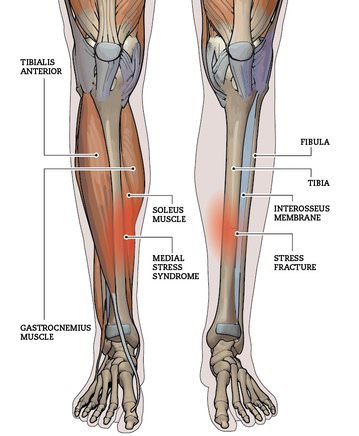Shin splints or MTSS is one of the commonest causes of exercise-related leg pain in athletes, particularly those who have increased the intensity of workouts or training regimes. They are also common in military recruits and in dancers.
Although the term shin splints is commonly used to describe shin pain related to activities such as running, medial tibial stress syndrome is now preferred. This is to distinguish it from other causes of shin problems also called shin splints, such as a stress fracture of the tibia.
What Are Shin Splints?
Shin splints or MTSS is a condition of pain over the inside border of the shin bone, usually in response to repetitive weight-bearing. There may be inflammation of tendons, irritation of the tissue layer on the bone surface (periosteum) and a stress-related reaction in the bone.
What Causes Shin Splints?
This condition is most common in military recruits, runners, gymnasts, dancers and soccer players. The typical cause is a training error such as an inappropriate increase in exercise levels over a very short time. The increased intensity stresses the tissues too greatly and a pain problem results. Running on uneven or hard surfaces and long distances makes this problem more likely along with several others.
Shin Splints Symptoms
- Pain over the inner border of the shin bone – achy and vague
- Worse during at the start of exercise, eases with activity and settles quickly after stopping. As it worsens it becomes easier to bring on the pain and it may even be present at rest.
- Tenderness over a wide area of the inner shin bone and nearby muscle (stress fracture pain is more localised)
Another cause of shin pain can be chronic exertional compartment syndrome (CECS) which can give tight, cramping, aching or burning pain over the affected area during exercise. Compartment syndrome is potentially very serious and if the leg should swell or become extremely painful or change colour, medical advice should be sought.
A third potential cause is a stress fracture of the tibia, which needs different management from MTSS.
Shin Splints Treatment
Physiotherapists will use the PRICE protocol initially to reduce inflammation and allow the condition to settle.
- Stopping or reducing the aggravating activity is essential and often not well accepted by athletes. A reduction in the activity by 50% and avoiding uneven ground and slopes may be a good compromise. Running in a hydrotherapy pool or using an eccentric trainer may be good substitutes for normal running.
- Stretching and strengthening of the calf muscles can be followed by a paced return to the problem activity.
- Analysis of lower limb posture, both statically and while walking or running, is essential at this stage. Postural abnormalities such as flat foot and over-pronation of the foot in running can increase stresses on the foot muscles and contribute to pain in the shin. Orthotics such as insoles may be useful in allowing a person to continue their activity without increased pain.
- Good footwear can reduce the risk of MTSS. Shoes should have good shock absorbing and posture correcting capabilities. Wet shoes work much less well so a replacement dry pair should be available. As shoes lose 40% of their ability after 250 to 400 miles, they need regular replacement.
- Prevention is the key to avoiding the onset of MTSS or its recurrence, which is common.
References:
- Galbraith, R. M., & Lavallee, M. E. (2009). Medial tibial stress syndrome: conservative treatment options. Current Reviews in Musculoskeletal Medicine,2 (3), 127–133. http://doi.org/10.1007/s12178-009-9055-6
- Shin Splints. AAOS.
Last Review Date: 09-02-2020
Next Review Date: 06-02-2022

